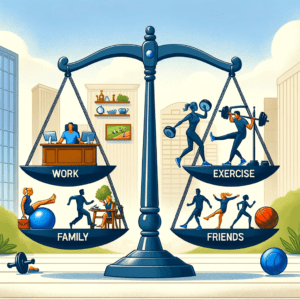Introduction:
In the whirlwind of modern life, juggling work, family, and health can feel like a circus act. But, as I’ve discovered, it’s not only possible to fit exercise into a hectic schedule, it can also be a lot of fun! Drawing from my own experiences and a sprinkle of wisdom from industry gurus, I’m excited to share how I keep fit while keeping up with life’s fast pace.
“Maintaining friendships. Building a great company. Spending time w/family. Staying fit. Getting sleep. Pick 3.“
~ Randi Zuckerberg
The Importance of Exercise:
We all know exercise is the secret sauce for mental sharpness and physical health. The American Heart Association suggests a hearty 150 minutes of moderate exercise weekly, yet a CDC survey shows only 23% of us hit that mark. Clearly, we’re all in the same boat, trying to row with too few hours in the day.
My Personal Strategies:
- Work-Exercise Integration:
- Taking a leaf out of Tim Ferriss’s “The 4-Hour Workweek,” I’ve turned my home office into a mini-gym. Picture this: peddling away on my Zwift, while diving into the latest on Salesforce+ or watching an on-demand webinar – it’s multitasking (multi-cycling?) with a fitness twist!
- Mindful Movement:
- Embracing Robin Sharma’s “The 5 AM Club,” my day kicks off with a dog walk (although not yet at 5am!) that’s more zen than chore. It’s my ‘me time’ to soak in the morning vibes and prep for the day – a small step for fitness, a giant leap for mindset!
- Family Fitness:
- Inspired by Stephen Covey’s wisdom, family time is also fitness time. On rainy days our living room transforms into a dance floor with Nintendo Switch sessions, proving workouts can provide family hilarity. Otherwise we are getting outside to kick a ball or ride bikes. I want to be a roll-model to my son, and one important part of that is showing him that exercise is an essential part of my life, and also something we can do together.
- Social Exercise at Work:
- Channeling Laura Vanderkam’s ethos, I started a run club at work (which needs a New Year reboot!) It’s our way of mixing fitness with friendly banter – who knew networking could be so sweaty? Hit me up if you ever want to turn one of our meetings into a walk or run together, or want to join the A&C run club.
- Efficient Workouts:
- On those jam-packed days, I rely on apps like FitBod for a quick fitness fix. It’s the espresso shot of exercise – short, sharp, and surprisingly effective.
- Social Sports:
- Incorporating social elements into your fitness routine can enhance the experience. I play in a Wednesday night Futsal league and also love a cycle with fellow MAMIL’s for a weekend catch up with a half-way coffee up at Palm Beach. It’s a great way to combine exercise with social interaction, making your workout something to look forward to.
Challenges and Improvements:
This fitness journey is a marathon, not a sprint. I’m constantly scouting for new activities to keep the flame alive and haver been incorporating yoga and swimming recently. It’s about keeping it fresh and fun.
Call to Action:
I’m all ears for your fitness hacks! How do you weave exercise into your busy life? Drop your stories and strategies in the comments – let’s inspire each other.
Conclusion:
Fitting fitness into a busy schedule is a blend of creativity, commitment, and a dash of humour. By sharing my story, I hope to encourage you to find your own rhythm in the fitness dance. Remember, it’s about making time, not having time. Here’s to laughing our way to a healthier life!
